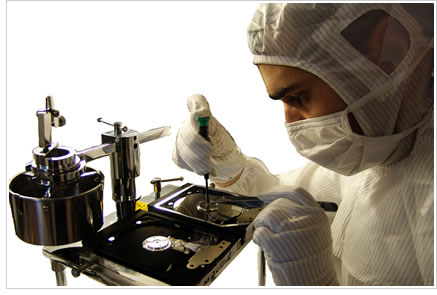Clean Room Technology:
Clean rooms are standard in the assembly and service of hard disks:
Cleanroom technology is used in a wide range of industries including semiconductor assembly, biotechnology, pharmaceutical, aerospace, food, medical devices and hospitals, and other areas where high levels of cleanliness are required. They are lab environments with controlled temperature and humidity standards to ensure that sensitive technology is at no risk of damage or contamination.
The walls and ceilings are made of plastic, the light source is external and a ventilation system ensures a continuous stream of clean, dust-free air. The labs are frequently extensively cleaned. If these clean room standards are not met, contaminants can settle into the platters causing them scouring damage that often results in data loss.
During the installation of clean room walls, special care is taken to prevent material particles from entering the room and thus posing a contamination risk. A particle enclosure is used to trap these particles because they are not easily removed once they get into the clean room area. When high cleanliness levels are required, the Federal Standard STD-209E form is used.
This standard outlines the airborne particle cleanliness classes. Class names are given to each class limits and these limits designate specific concentrations of airborne particles found in the clean room.
Works with all data recovery scenarios including, but not limited to:
Hard drives not mounting on the desktop or not being recognized by the operating system, Drives that make clicking patterns, Drives with burned chips on the logic board, Drives that won't spin up due to electronic failure or frozen spindles, Invalid catalog trees or FAT table partitions, Drives that were ghosted with another operating system, Drives with physical damage, such as being dropped, Drives with fire or flood damage, Other problems such as deleted files, formatted disks, or virus attacks.
High standards:
The clean room is enclosed in a shell with ventilators and other safeguards to separate the air in the clean room from the rest of the building.
Clean rooms operators and technicians must wear gloves, masks, head covering and special non-linting body-suits. In cases where the utmost levels of cleanliness are demanded, workers pass through an air blast to remove all potential contaminants.